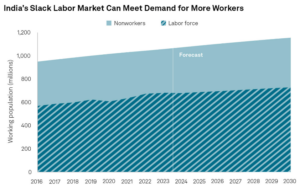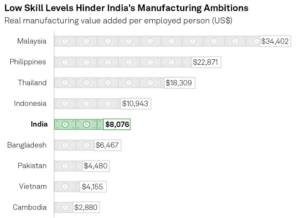
India is currently enjoying a period of demographic advantage, where the working-age population significantly outnumbers the dependent elderly and young. The demographic dividend is often heralded as a potential game-changer for India’s economic trajectory, promising unprecedented growth and prosperity. However, a closer examination of current trends and historical precedents suggests a grim reality: India is at risk of squandering this golden opportunity due to systemic failures in economic management, employment generation, and policy foresight.
The demographic dividend presents a unique window of opportunity for India. Historically, nations that have capitalised on this demographic phase, such as China and South Korea, have experienced rapid economic growth and development. For India, with its large and young population, the expectations are high. The country’s workforce is swelling by approximately 10-12 million individuals annually, a figure that highlights the potential for economic dynamism and increased productivity.
READ I A New Deal: Modi 3.0 must address economic inequality
Employment crisis and demographic dividend
Despite the optimistic projections, India’s ground realities paint a starkly different picture. The country’s economy, although one of the fastest growing, has not translated this growth into substantial employment opportunities, particularly for its youth. The employment rate, especially among the educated youth, remains alarmingly high, with job creation failing to keep pace with the number of entrants into the job market. This discrepancy highlights a critical flaw in India’s growth model: the growth is not employment-centric.
The biggest concern for India is the quality of jobs that are being created. The surge in gig economy jobs and informal sector employment, while providing immediate livelihood options, does not offer long-term security or career progression. This type of employment is often precarious, lacking in benefits and job security, and does not contribute to sustainable economic development.
Unmet potential of manufacturing sector
A significant aspect of leveraging the demographic dividend involves bolstering the manufacturing sector to create large-scale employment. However, India’s manufacturing sector has not yet become the engine of job creation it was hoped to be. Initiatives like ‘Make in India’ have not sufficiently reversed the trend of declining manufacturing employment. The sector’s growth is hampered by bureaucratic hurdles, infrastructural deficiencies, and a lack of concerted policy support to make Indian manufacturing globally competitive.

Despite the focus on industrialisation and service sector growth, a significant portion of India’s population remains employed in agriculture. This sector’s low productivity and underemployment contribute to economic inefficiencies and fail to utilise the demographic dividend effectively. Modernising agriculture, enhancing agribusiness, and integrating rural economies with urban markets are essential to transition the surplus labour to more productive sectors.
Education mismatch and skill gap
The potential of demographic dividend is further undermined by the educational system’s shortcomings. There is a growing mismatch between the skills imparted by India’s education system and the market’s demands. This mismatch has led to a situation where the rate of educated unemployment is very high. The workforce, although numerically large, lacks the skills and training necessary to be absorbed into sectors that contribute significantly to the country’s GDP.

In the global digital economy, innovation and technology play pivotal roles in shaping competitive advantages. India’s slow pace in adopting new technologies and fostering innovation ecosystems limits its economic growth potential. Encouraging research and development, supporting tech startups, and investing in digital infrastructure can drive job creation, especially for the young and educated workforce.
Policy paralysis and missed opportunities
Policy making in India has been marked by incremental changes rather than the transformative reforms needed to harness the demographic dividend effectively. While there have been efforts to improve the business environment and attract investment, these have not been sufficient to drive large-scale employment generation. The lack of a coherent industrial and employment policy, coupled with inconsistent implementation, has resulted in missed opportunities to stimulate economic sectors that could provide mass employment.
Another critical aspect is the underutilisation of female labour in India’s workforce. Cultural norms and lack of supportive infrastructure, such as childcare and transportation, restrict women’s participation in the economy. Addressing these barriers and empowering women to contribute to the workforce is essential for realising the full potential of India’s demographic dividend.
Need comprehensive reforms
To avert the looming crisis of squandered potential, India must undertake comprehensive reforms. These should aim at creating an ecosystem that fosters job creation, entrepreneurial growth, and inclusive development. Prioritising sectors like manufacturing and services with the potential for mass employment and export growth, alongside a focus on high-quality education and skill development, is crucial.
The Narendra Modi government must address infrastructural bottlenecks and bureaucratic inefficiencies that hinder business growth. Creating a conducive environment for startups and fostering innovation can also drive job creation, tapping into the entrepreneurial spirit of India’s youth.
India’s demographic dividend is not a guaranteed ticket to economic prosperity but a fleeting opportunity that requires strategic planning, robust policy frameworks, and decisive action. The current trajectory, marred by employment challenges, educational mismatches, and policy gaps, signals a potential squandering of this demographic advantage. However, with targeted reforms and a clear vision, India can steer its vast workforce towards a path of sustainable growth and development, ensuring that the demographic dividend translates into a lasting legacy of prosperity and progress.
